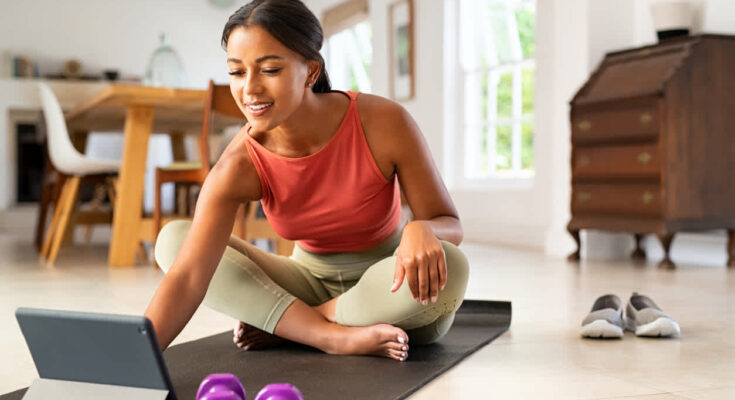Embarking on a fitness journey can seem daunting at first, especially if you’re starting from scratch. However, with the right guidance and strategies, anyone can establish a successful exercise routine.
This comprehensive guide will provide you with essential tips and advice on how to begin your fitness journey effectively.
Why exercise?
Regular exercise has been shown to improve your health significantly.
Its primary benefits include helping you achieve and maintain a healthy body weight and muscle mass and reducing your risk for chronic diseases.
Additionally, research has shown that exercise can lift your mood, boost your mental health, help you sleep better, and even enhance your sex life.
And that’s not all. It can also help you maintain good energy levels.
In short, exercise is powerful and can help improve your life.
Common types of exercise
There are various types of exercise, including:
- Aerobic. The core of any fitness program should include some form of continuous movement. Examples include swimming, running, and dancing.
- Strength. These exercises help increase muscle power and strength. Examples include resistance training, plyometrics, weightlifting, and sprinting.
- Calisthenics. These moves are usually performed without gym equipment using large muscle groups. They’re done at a medium aerobic pace. Examples include lunges, situps, pushups, and pullups.
- High-intensity interval training (HIIT). This type of exercise includes repetitions of short bursts of high-intensity exercise followed by low-intensity exercises or rest periods.
- Boot camps. These are timed-based, high-intensity circuits that combine aerobic and resistance exercises.
- Balance or stability. These exercises are designed to strengthen muscles and improves body coordination. Examples include Pilates, tai chi poses, and core-strengthening exercises.
- Flexibility. These types of exercises help muscle recovery, maintain range of motion, and prevent injuries. Examples include yoga or individual muscle-stretch movements.
The activities above can be done individually or combined. The important thing is to do what works best for you and to have fun with it.
How to get started
It’s essential to consider a few things before starting a new workout routine.
1. Check your health
It’s important to consult your healthcare provider and get a physical medical examination before starting an exercise routine.
This is particularly important for those new to strenuous and vigorous physical activities.
An early checkup can detect any health problems or conditions that could put you at risk for an injury during exercise.
It can also help you optimize your workout, making it easier for you and your personal trainer, if you choose to work with one, to understand your limitations and create an exercise plan tailored to your particular needs.
2. Make a plan and set realistic goals
Once you decide to start exercising regularly, try to create a plan that includes attainable steps and goals.
One way to do this is to start with a plan of easy steps to follow. Then you can continue building on it as your fitness level improves.
For example, if your goal is to finish a 5-kilometer run, you can start by building a plan that includes shorter runs.
Once you can finish those short runs, increase the distance until you can run the whole 5 kilometers in one session.
Starting with small achievable goals will increase your chances of success and keep you motivated every step of the way.
3. Make it a habit
Another key component of exercise success is to stick to your routine.
It seems to be easier for people to maintain an exercise routine in the long term if they make it a habit and do it regularly.
A review of studiesTrusted Source concluded that replacing an unhealthy behavior with a new healthier habit is an excellent approach to maintaining it in the long term.
Furthermore, making a schedule or exercising at the same time every day are good ways to sustain your routine and make it last.
For example, you can make exercise a habit by planning to work out right after work every day or first thing in the morning. It’s important to choose a time that works best for you.
A few tips for beginners
1. Stay hydrated
Drinking fluids throughout the day is essential for maintaining healthy hydration levels.
Replenishing fluids during exerciseTrusted Source is essential for maintaining optimal performance, especially when exercising in hot temperatures.
Moreover, hydrating after your workout can help you recover and get you ready for your next training session.
2. Optimize your nutrition
Be sure to consume a balanced diet to support your fitness program.
All food groups are necessary to sustain healthy energy levels and get the most out of your workout. Carbs are vital, as they can fuel your muscles before exercise.
Carbs are also important after exercise to replenish glycogen stores and assist with the absorption of amino acids into your muscles during recovery.
Additionally, protein helps improve muscle recovery after exercise, repairs tissue damage, and builds muscle mass.
Lastly, regularly consuming healthy fats has been shown to help burn body fat and preserve muscle fuel during workouts, making your energy last longer.
Click these links for more info about pre-workout and post-workout nutrition.
3. Warm up
It’s important to warm up before your workout. Doing so can help prevent injuries and improve your athletic performance.
It can also help improve your flexibility and reduce soreness after your workout.
Simply start your workout with some aerobic exercises like arm swings, leg kicks, and walking lunges.
Alternatively, you can warm up by doing easy movements of the exercise you’re planning to do. For example, walk before you run.
4. Cool down
Cooling down is also important because it helps your body return to its normal state.
Taking a couple of minutes to cool down can help restore normal breathing patternsTrusted Source and even reduce the chance of muscle soreness.
Some cool-down ideas include light walking after aerobic exercise or stretching after resistance training.
5. Listen to your body
If you’re not used to working out every day, be mindful of your limits.
If you feel pain or discomfort while exercising, stop and rest before continuing. Pushing through the pain is not a good idea, as it can cause injuries.
Also, remember that working out harder and faster is not necessarily better.
Taking your time to progress through your fitness program can help you maintain your routine in the long term and make the most of it.
How to Stay Motivated
The key to staying motivated and making exercise a habit is to have fun while doing it. This helps you to not dread exercising.
Like the sample exercise program shown above, you can mix up activities while keeping it fun for you.
If you’re able to and want to, joining a gym or taking a virtual fitness class like yoga or Pilates, hiring a personal trainer, or doing team sports are good ideas to help increase motivation and enjoyment.
Working out as a group or with a friend can also help maintain accountability and motivate you to keep up your exercise routine.
Furthermore, tracking your progress, such as logging your weightlifting levels or noting your running times, can help keep you motivated to improve your personal records.
Embracing the Journey
Finally, remember that fitness is a lifelong journey, not a destination. Celebrate every step forward, no matter how small, and be patient with yourself. With determination and the right approach, you’ll build a healthier, happier you.
Embarking on your fitness journey is an exciting step towards improving your health and wellbeing. By setting realistic goals, choosing the right exercises, and embracing a balanced and gradual approach, you’ll set the foundation for a successful and sustainable fitness routine. Remember, consistency, nutrition, and listening to your body are key components of any effective workout plan. As you progress, keep monitoring your achievements and seek support to stay motivated. Fitness is a personal journey, and by following these guidelines, you’re on your way to a healthier, more active lifestyle.



